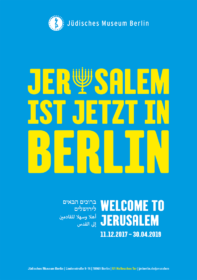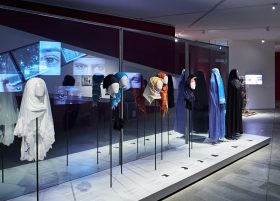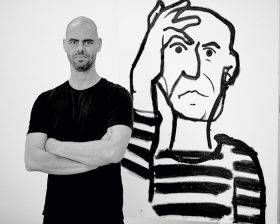How school children react to the tour through the exhibition Welcome to Jerusalem. A conversation with Marc Wrasse

Campaign for the exhibition Welcome to Jerusalem; Jewish Museum Berlin, designed by: Preuss und Preuss GmbH
You’ve worked for the Jewish Museum Berlin for many years, as well as for other museums. What makes this exhibition special?
The Jewish Museum Berlin has a wide variety of visitors—the audience here is nearly as diverse as the modern world itself. If you visit the museum or work here, you can have a lot of different experiences, including in experimental exhibitions such as Obedience (more information about the exhibition on our website). Due to their social and political significance, I always find encounters during tours through Welcome to Jerusalem (more on our website) to be something special. Muslim students in particular—and that label encompasses much variety, ranging from the third-generation Turkish people in Germany to Syrian war refugees with their anti-Israeli background—are highly attentive in this exhibition.
Why is that, in your opinion?
→ continue reading
Our visitors on Cherchez la femme
For over three months, the exhibition Cherchez la femme has allowed visitors to explore the topic of women’s head coverings in three of the world’s major religions. Among other things, the exhibition demonstrates that the borders of (religious) clothing rules are constantly being redrawn and reinterpreted.
Since we’re very interested in the opinions of our visitors, we asked around about what people thought at the exhibition:
Christian (39), Ludwigsburg, pastor, teaches German and history
Which object did you like the best?

Different kinds of head coverings; Jewish Museum Berlin, photo: Yves Sucksdorff
The gallery with the different kinds of head coverings. I was impressed by the attention to detail. For example, I didn’t know how many differences
there were between headscarves, between Turkish and Arab styles.
What significance does your own hair have to you?
It’s important to me that I look good. I go to the barber regularly.
Would you say that you follow any clothing rules? → continue reading
An Interview with Eran Shakine
Today, on 27 October 2016 at 7 pm, our exhibition “A Muslim, a Christian, and a Jew” is opening with Eran Shakine in attendance. In the run-up to the opening, Gregor H. Lersch spoke with the Israeli artist about religion, art, and his sources of inspiration.

Eran Shakine; photo: Shay Kedem
Gregor H. Lersch: What does “A Muslim, a Christian and a Jew” (MCJ) show?
Eran Shakine: “A Muslim, a Christian and a Jew…” sounds like the beginning of a joke. But that is just to get your attention.
The show is an installation consisting of 40 paintings, drawings, and three metal cut-out sculptures.
The three similar figures, their religious background unidentifiable, create situations by means of a vivid and comical body language. In every drawing they witness and experience major events in history or philosophy, or meet important figures like Moses, Buddha or Nelson Mandela. The three heroes, dressed as 19th century gentlemen, help each other in their journey to find the love of God.
Here, there are no stereotypes, no one is the laughingstock, everyone is the same; we see three human beings who explore life, nature, culture and philosophy, out of shared curiosity, without trying to prove each other wrong.
Why did you start to work on MCJ? → continue reading


